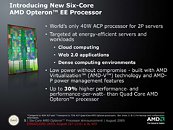- Joined
- Oct 9, 2007
- Messages
- 47,880 (7.38/day)
- Location
- Dublin, Ireland
| System Name | RBMK-1000 |
|---|---|
| Processor | AMD Ryzen 7 5700G |
| Motherboard | Gigabyte B550 AORUS Elite V2 |
| Cooling | DeepCool Gammax L240 V2 |
| Memory | 2x 16GB DDR4-3200 |
| Video Card(s) | Galax RTX 4070 Ti EX |
| Storage | Samsung 990 1TB |
| Display(s) | BenQ 1440p 60 Hz 27-inch |
| Case | Corsair Carbide 100R |
| Audio Device(s) | ASUS SupremeFX S1220A |
| Power Supply | Cooler Master MWE Gold 650W |
| Mouse | ASUS ROG Strix Impact |
| Keyboard | Gamdias Hermes E2 |
| Software | Windows 11 Pro |
AMD today announced the immediate availability of the new Six-Core AMD Opteron EE processor at 40W ACP. Delivering up to 31 percent higher performance-per-watt over standard Quad-Core AMD Opteron processors, the Six-Core AMD Opteron EE processor is tailored to meet the demands of customers who need strong performance, but must trim out every watt possible in a server system and reduce the datacenter's power draw.

View at TechPowerUp Main Site

- Many customers requiring this very low power processor deploy dense, large-scale IT projects where system power trumps raw performance and every watt of power savings can have significant positive impact on the bottom line
- AMD offers a wide range of energy-efficient processors; customers now have 15 low and very low power server processor choices available
- All of AMD's low power processors are fully-featured and available with the same AMD Virtualization (AMD-V) technology and AMD-P features for advanced virtualization and power savings capability as standard power versions
- This 40W ACP processor is currently being integrated in custom solutions programs and will be available from system builders for cloud and Web 2.0 customers where density and low power are key considerations
View at TechPowerUp Main Site







